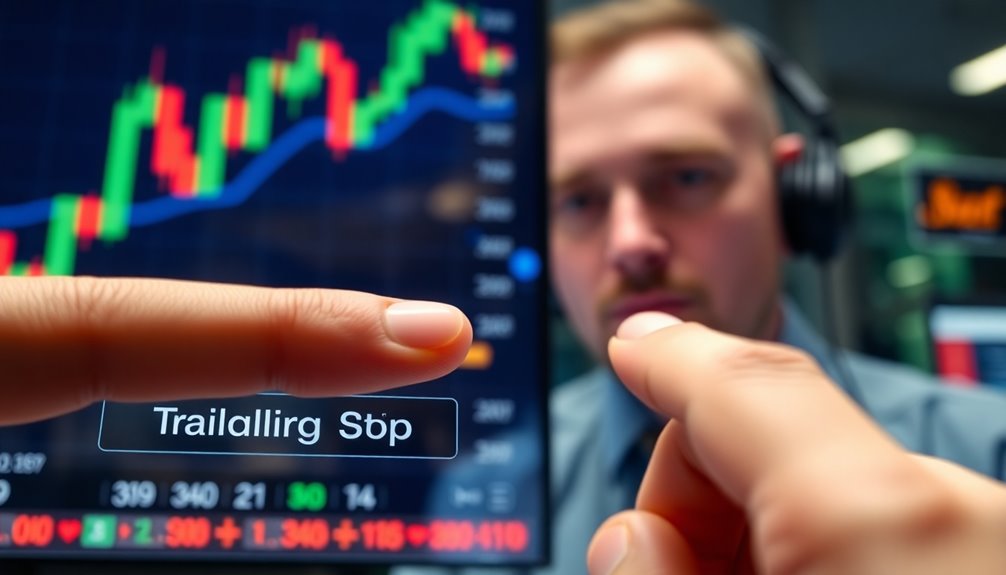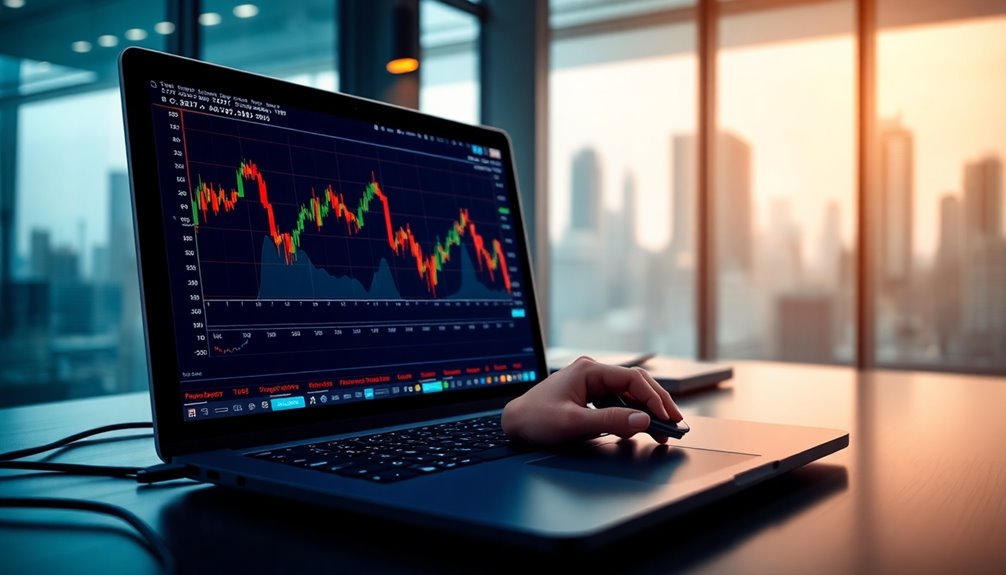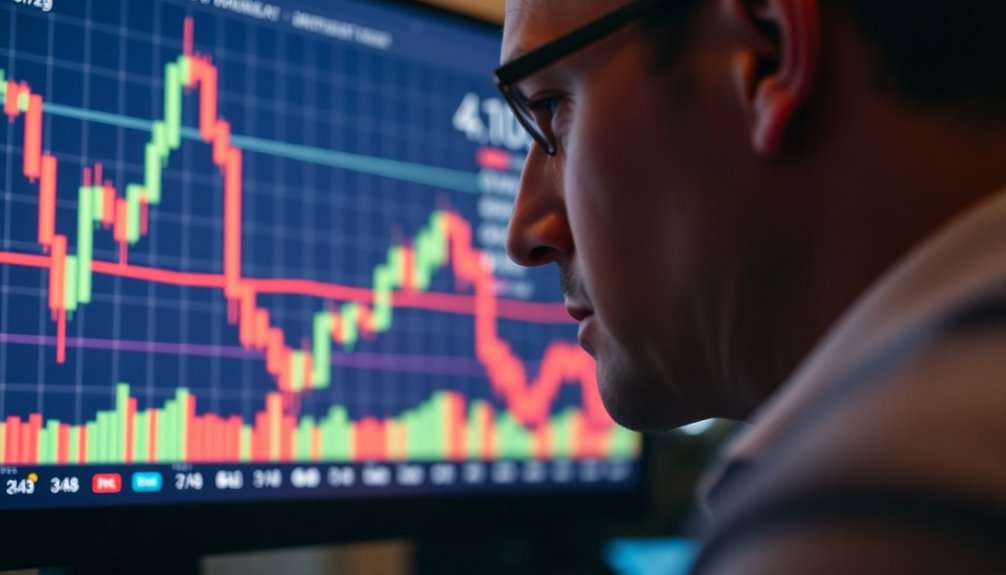A trailing stop order is a trading tool that helps you lock in profits while reducing potential losses. It automatically adjusts your stop price based on market movements. If you set a sell order, the stop price rises with the market but stays fixed if the price drops. For a buy order, the stop value decreases as the price falls and remains static if the price increases. This approach assists in managing risk effectively, especially in volatile markets. If you're curious about how to implement this strategy successfully, there's more to explore.
Key Takeaways
- A trailing stop order is a stop order that adjusts automatically with market price fluctuations to lock in profits or limit losses.
- For sell orders, the stop price rises with the market; for buy orders, it falls, remaining static in adverse movements.
- It helps traders automate stop-loss decisions, reducing emotional trading and maintaining positions during upward trends.
- Trailing stops can protect against significant losses but may trigger prematurely in volatile markets due to quick price swings.
- Regular adjustment and monitoring of trailing stops are essential to adapt to changing market conditions and optimize performance.
Order Type Explanation

A trailing stop order is a dynamic tool that helps you lock in profits while limiting potential losses. It adjusts the stop loss level as the market price moves in your favor.
For sell orders, the stop value trails the market price upward but stays the same if the price drops. Conversely, for buy orders, the stop value decreases as the market price falls, remaining static when the price rises. A trailing stop order is particularly useful as it serves as an essential risk management tool that allows traders to secure profits while minimizing potential losses.
You can set the trailing stop with a specific offset, whether as a percentage or a dollar amount, linking it to various price types like LAST or BID. This flexibility allows you to manage your trades effectively, maximizing gains while minimizing risks.
Understanding Trailing Stop Orders

Understanding trailing stop orders can significantly enhance your trading strategy by providing a structured approach to managing risk and capturing profits.
These orders help automate the stop-loss process, reducing stress and emotional decision-making. As the market rises, you can lock in profits while maintaining your position, protecting against significant losses. Additionally, trailing stop orders are designed to protect gains by enabling a trade to remain open and continue to profit as long as the market price is moving in a favorable direction.
However, you need to be cautious; trailing stop orders may not suit everyone, especially those with low risk tolerance. They can lead to premature exits in normal fluctuations if the stop distance isn't set correctly.
Striking the right balance is crucial, as setting the stop too close may result in frequent exits, while setting it too far risks larger losses.
Always stay vigilant and monitor market conditions.
Mechanism of Price Adjustment

When you set a trailing stop-sell order, it automatically adjusts to market movements, ensuring your stop price follows the upward trend.
You start by choosing a trailing amount, either a percentage or dollar value, below the current market price. For example, if the market price is $62.46 and your trailing amount is $0.20, your initial stop price would be $62.26.
As the market price rises, your stop price increases accordingly. If the price reaches $14.00 with a trailing amount of $0.25, your stop price adjusts to $13.75. This mechanism allows traders to effectively balance profit preservation while managing risk.
However, if the market price falls, the stop price remains unchanged, ensuring you maintain your position until it's triggered when the market price falls to or below the stop price.
Pros and Cons Summary

Setting up a trailing stop order can be a powerful tool for managing your trades, but it's important to weigh the pros and cons before using it.
On the plus side, it helps manage risk by automatically exiting trades that move against you, locks in profits as prices rise, and reduces stress with its dynamic stop-loss feature. Plus, it automates your exit strategy, allowing for more flexibility. This type of order can adapt to market movements, ensuring you secure gains while providing a safety net against potential losses.
However, there are drawbacks. Market gaps can lead to slippage, and executing a trailing stop can be complex. You might also face delays in fast markets, and relying too much on this method can cause you to overlook market changes.
Trailing vs. Fixed Stop Orders

Choosing between trailing stop orders and fixed stop orders can significantly impact your trading strategy.
Trailing stop orders adjust automatically as the market price moves, locking in profits while limiting potential losses. They provide flexibility, as you don't need to constantly monitor and adjust your stop-loss levels. This order type also allows traders to set a specific distance for trailing, adapting to market conditions as they change.
In contrast, fixed stop orders have a static price and require manual adjustments, which can lead to missed profit opportunities if the market moves favorably. While fixed stops can work, they may not be as effective in volatile markets.
Market Volatility Impacts Effectiveness

Market volatility presents unique challenges for traders using trailing stop orders. High volatility can trigger your stops prematurely, leading to frequent stop-outs that negate potential gains. Quick price swings often activate your stop losses before the market stabilizes, causing frustration. Additionally, market gaps can dip asset values below your stop level without execution, while slippage during news releases can worsen execution prices. You'll need to adjust your trailing stop settings carefully; overly tight settings can terminate trades too soon, while too loose settings may not provide adequate protection. Balancing these factors is crucial, as trailing stops may not fully shield you from sharp declines. Trailing stops automatically adjust in response to market price changes, enhancing profit protection by maintaining a set distance from the market price during upward trends. Continuous monitoring and manual adjustments are necessary to optimize your performance in volatile conditions.
Algorithmic Trading Adoption Increase

As technology continues to advance, the adoption of algorithmic trading is skyrocketing among traders and institutions alike.
With machine learning and artificial intelligence, you can analyze massive data sets in real time, improving decision-making. Quantum computing boosts processing capabilities, making trades faster and more efficient.
Advanced algorithms adapt and learn from historical performance, allowing you to stay ahead in changing markets. Regulatory bodies ensure fair practices, fostering a stable environment for your trading activities. The global algorithmic trading market is projected to grow significantly, driven by demand for automation and reduced transaction costs. This shift not only enhances market liquidity but also minimizes human error, leading to more consistent execution of strategies you can trust.
The global algorithmic trading market is expected to reach USD 41.9 Billion by 2030, indicating a strong future for this innovative trading approach.
Set Trailing Stop Distance Wisely

How do you determine the right trailing stop distance for your trades? Start by assessing the asset's daily volatility; for stocks, consider a range of 8-12% for short-term trades and 15-20% for longer holds.
In volatile markets, avoid tight stops to prevent premature exits. For cryptocurrencies, wider stops of 20-25% are often necessary.
You can use either a percentage method or a fixed amount, depending on market conditions. Remember to limit your risk to 1-2% of your total account value per trade. Additionally, consider incorporating a trailing stop order to maximize profit potential while minimizing loss exposure.
If market volatility increases, adjust your stop distance accordingly. Automated trailing stops can help you maintain consistency and avoid emotional decisions, ensuring your strategy remains objective.
Frequently Asked Questions
Can Trailing Stop Orders Be Used With All Asset Types?
Yes, you can use trailing stop orders with various asset types, including stocks, forex, and commodities.
They're particularly beneficial in volatile markets, helping you manage risk and lock in profits.
Whether you're trading futures or options, trailing stops can adapt to your strategy.
Just keep in mind that availability may vary depending on your brokerage platform and market regulations, so check with your broker to ensure you can utilize this order type.
How Does a Trailing Stop Order Affect Tax Implications?
When you trigger a trailing stop order, it can impact your tax implications significantly.
If you sell an asset held for less than a year, you'll face higher short-term capital gains taxes.
Additionally, if you repurchase the same or similar securities within 30 days, wash sale rules may disallow any capital losses.
To minimize tax liability, it's essential to strategize your selling timing and consult a tax professional for guidance.
Are There Any Broker-Specific Limitations on Trailing Stop Orders?
When you're navigating the choppy waters of trading, knowing your broker's limitations on trailing stop orders is like having a lighthouse guiding your way.
Different brokers have unique configurations, which can either empower or restrict your trading strategy. You might find variations in order types, the trailing amount you can set, and even how orders are managed.
It's crucial to familiarize yourself with your broker's specifics to avoid surprises that could derail your trading plan.
What Happens if the Market Closes While My Trailing Stop Is Active?
If the market closes while your trailing stop is active, it won't execute until trading resumes.
The order stays in force but dormant, tracking price changes once the market reopens.
Be aware that when trading resumes, gaps can occur, affecting your execution price.
Can I Modify a Trailing Stop Order Once It's Set?
Did you know that around 70% of traders modify their stop orders as market conditions change?
Yes, you can modify a trailing stop order once it's set, as long as it hasn't filled or your brokerage hasn't restricted changes.
You can adjust parameters like the stop price and trailing amount.
Just remember, if you lack sufficient capital or exceed market conditions, your modifications mightn't go through.
Always check those limits!
Conclusion
In conclusion, a trailing stop order can be a powerful tool for managing risk while maximizing potential gains. For instance, imagine you buy a stock at $50 and set a trailing stop at $5. If the stock rises to $70, your stop would adjust to $65. If it then dips to $65, you'd sell, locking in profits of $15 per share. By using trailing stops wisely, you can navigate market fluctuations more effectively and protect your investments.









